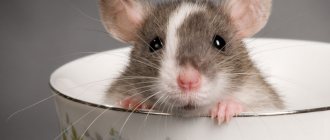Hamsters belong to the subfamily of rodents, order Hamsters. There are about 400 species in total. Most of them live only in nature and are not suitable for home keeping. At home they contain only 5-8 species.
Hamsters are quite easy to keep at home. They do not require much care and are easy to tame. They rarely show aggression and bite. One of the disadvantages of keeping hamsters is their low life expectancy. Hamsters rarely reach the 5 year mark, the average duration is only 2-3 years and depends on the breed of hamster. There are only 5 most popular species for keeping at home.
Breeds of hamsters for home keeping:
- Dzungarian.
- Syrian.
- Angora
- Campbell.
- Roborovsky.
Albinos are also born among hamsters. Albinos can occur among any species, as well as among any other animals.
What types of hamsters are there?
Rodents vary in color, size and coat type. There are five types of domestic hamsters in total. Their standards, The National Hamster Council, are set by the National Association of Hamster Fanciers of England.
Syrian hamster
This is the largest Syrian Hamsters from home. The average length of its body is 13 cm. Females are sometimes larger than males.
The classic color of the Syrian hamster is golden brown. There is black ticking on the back - this means that areas of different colors alternate on the hairs. The animal's belly is white with gray undercoat, and there are dark spots on its cheeks.
Individuals of other colors are often found: white, cream, brown, black, gold, silver-gray, striped.
Hamsters of this species can have different coats. There are four types in total:
- Short . The soft fur fits snugly to the body.
- Long . The length of the hairs is from 7.5 to 10 cm.
- Rex . The fur appears tousled.
- Satin . The hair has a glossy shine. It is not recommended to crossbreed two hamsters with such hair, because sometimes the offspring will be bald.
Syrian hamster with classic color. Photo: Olena Kurashova / Shutterstock
Campbell's Russian Hamster
The body length of such a rodent, Dwarf Exhibition Standards, is 10–12 cm. There are three main colors of the animal:
- Normal . The hairs on the back are brown. The belly is white with gray undercoat. The eyes are black.
- Argenta . The top layer of wool is orange-sand, the bottom is smoky-gray. The eyes are red.
- Albino . These are completely white pets with bright pink eyes.
Hamsters with gray, beige, black and chocolate fur are considered non-standard.
Campbell's Russian hamster with normal color. Photo: softkrafts.live.com/Depositphotos
Djungarian hamster
This Dwarf Exhibition Standards animal is sometimes called the Russian white dwarf hamster. Its body length is 8–10 cm. All pets of this species have a black stripe on their backs. There are only three colors:
- Normal . The body is dark brown, with black ticking on a third of the hairs. The paws and belly are white, and the ears are gray.
- Pearl . The rodent's fur is white.
- Sapphire . The fur on the back is smoky gray with a blue tint, the belly is white.
Sapphire colored Djungarian hamster. Photo: Faifarris4746/Shutterstock
Chinese hamster
This rodent looks like a mouse without a long tail. Its body length is 10–12 cm, weight is 45–50 g. There are two main colors of the Chinese Hamster animal:
- Normal . The back and sides are brown with a chestnut tint, the belly is white. A black stripe stretches from the forehead to the tail.
- Spotted . Most of the fur is white. There is an elongated brown spot along the spine.
Albinos with black eyes are extremely rare. They come in litters from spotted parents. But this is the exception rather than the rule.
Chinese hamster with normal color. Photo: alexvey/Shutterstock
Roborovsky's hamster
The smallest of domestic rodents. It weighs only 20–25 g, and its body length is 4.5–5 cm. Typically, these animals have golden-brown fur on their face and back. The roots of the hairs are gray, and there are light spots near the eyebrows. But very rarely there are hamsters with a white muzzle.
Roborovsky's hamster. Photo: Anyarnia/Shutterstock
Additional questions and answers
There are some important questions to consider before purchasing a rodent. This will help you choose the right animal and provide it with good conditions.
What is the smallest breed of hamster
Roborovsky hamsters are the smallest breed suitable for home keeping. Among wild rodents, “Taylors” stand out for their compact size.
What is the largest breed of hamster
Among domestic breeds, Syrians are considered the largest. Karbysh is the largest wild rodent.
Who is better to get - a Djungarian or a Syrian hamster?
Both breeds have their advantages and disadvantages. Thus, “Syrians” are larger, have an easy-going disposition and quickly learn to respond to a nickname. However, they need a spacious cage. Djungarian hamsters do not require much space. Now many varieties of this breed have been bred, so it is easier to choose an animal with the desired decorative qualities. Syrian hamsters are easier to care for.
What is the character of hamsters?
Rodents are active and curious Providing a Home for a Hamster. Animals are interesting to watch when they play in a cage. If a pet has been accustomed to communicating with a person since childhood, it can calmly sit in your arms. Hamsters rarely bite All About Syrian Hamsters: mainly when they are frightened by a sudden movement. Before communicating, for example, with Syriac, it is recommended to wash your hands. He has poor eyesight, so he relies on smell and touch. If the owner's fingers smell of food, the animal can taste them.
It is not worth keeping individuals in pairs. Even when they live together from an early age, conflicts can arise over time.
If you are still going to buy several animals, it is better to place them in different cages.
Keep in mind that rodents are nocturnal. They sleep during the day, so it is better to play with them in the evening. If you decide to wake up your All About Syrian Hamsters pet, do it very carefully. Talk to him in a gentle voice and lightly rustle the bedding in the cage.
Syrian
The second most popular species is the Syrian hamster. This species is medium-sized and much larger: the body length is considered to be 12 cm, but there are individuals up to 20 cm tall (this is the largest hamster among pets). The usual color is golden (reddish, peach). Often, for marketing purposes, sellers call this breed Royal, and the name Yellow Hamster is found. Many consider it the most beautiful breed.
There are simply countless decorative colors obtained as a result of selection. The Syrian can be of almost any color, as well as multi-colored.
The character is a little more absurd than that of the Djungarians, but you can tame the Syrian. Females are angrier than males, so we recommend boys for solitary housing. If you are planning to get several Syrian animals, house them separately, even in pairs (only house them for the duration of mating).
They live 3-4 years; long-livers have been known to live up to 5 years.
We have outlined everything you need to know about the maintenance and nutrition of the Syrian breed in this article.
Angora hamster
There is no breed of Angora hamster. This is often the name given to Syrians who are extremely shaggy and have long hair (up to 10 cm). Decorative breed, famous for its fluffiness. The coat requires additional care - keep this in mind if you are planning to get a shaggy hamster.
What living conditions does a hamster require?
It is best to house your hamster in a spacious wire cage, Choosing a Dwarf Hamster Cage. The minimum floor area is 60 × 30 cm. A plastic tray is considered a good option. But grated flooring is not suitable: your pet will easily injure its paws on it. The door of the home must close tightly. The distance between the rods is no more than 5 mm. Otherwise, the rodent may escape.
If you choose a multi-level design, pay attention to the height of the floors. The lower they are, the better. Then, when falling, the animal will not be seriously injured.
A pet store may offer you a plastic cage with pipes. Keep in mind: it will not provide adequate ventilation. In addition, it will be difficult to clean.
Hamsters are susceptible to cold and heat. They feel best at a temperature of 18–21 °C The ideal home for your hamster. Therefore, the cage is usually placed away from drafts, radiators and direct sunlight. If the room is too cold, the animal may hibernate. Loud sounds and vibrations cause stress in rodents. Therefore, it is worth finding a calm and quiet place for the house. There should be no TV or music system nearby.
Be sure to place a ceramic bowl inside the cage How to Care for Your Pet Hamster, and pour water into the nipple drinker.
A large layer of bedding should be laid on the pallet of the dwelling. Animals love to rummage in it. If you want to go with wood How to Care for Your Pet Hamster litter, choose aspen. Cedar and pine irritate the respiratory tract of hamsters.
The cage should also have shelter. The pet will rest there. If desired, you can buy a wooden or plastic house. Some owners use cardboard boxes. They wear out quickly, but are easy to replace.
Running wheel without cross supports. Photo: PetroP/Depositphotos
A hamster definitely needs a large running wheel. Try to find something that attaches to the cage. Typically, such models do not have transverse supports on which the animal can damage its paws. If you are a light sleeper, choose a quiet design.
To grind down the teeth that hamsters constantly grow, you will need wooden toys from Pet Hamster Toys. But some owners simply give their pets toilet paper or towel rolls instead.
Campbell's Hamster
Campbells are confused with Djungarians, since both of them are representatives of dwarf miniature rodents. The external difference lies in the bare hind limbs and side stripes on the skin. The color of the Campbell's fur skin is varied: sand, cream and brown.
These hamsters, unlike the Djungarian ones, are difficult to tame; they are not particularly friendly towards other rodents and people.
Do not put them in a cage with other types of hamsters, this will inevitably provoke a fight!
But don't think that the Campbell can't be tamed. This requires much more time, effort, love and patience. But perhaps this is what will make him especially dear to you!
What to feed a hamster
The majority of the diet should be prepared food What Can Hamsters Eat? , for example crumbly mixtures. They contain grains, seeds and dried vegetables. The disadvantage is that hamsters pick out the tasty morsels. Less tasty but healthy additives often remain in the bowl. Therefore, you need to make sure that the animal finishes everything. If you have no time to control your diet, it is better to choose granulated food.
Hamsters can also be given human food, but its amount should not exceed 10% of the diet. Here are examples of safe products:
- Vegetables : broccoli, carrots, cauliflower, cucumber, potatoes (cooked), spinach, cabbage.
- Berries : grapes, blueberries, strawberries.
- Legumes : young beans and peas, dry or steamed lentils, unsalted peanuts.
- Fruits : apples (without seeds), bananas.
Animals are also sometimes given hay, dandelion leaves, crickets and mealworms.
You cannot feed your hamster citrus fruits, raw potatoes, apple seeds, dry peas, onions, garlic, almonds, sweet and salty foods.
Neoplasms, tumors
Tumors (malignant, benign), pathological growths on the body, legs. ears is a fairly commonly diagnosed pathology in rodents, which can develop for a variety of reasons. Bumps can appear due to injuries, severe bruises, or falls from a height. To begin treatment, you need to establish a diagnosis, so take your pet to a veterinarian.
For benign and malignant tumors, surgical treatment will be prescribed. If the cancer is localized in a hard-to-reach area (oral cavity), or the tumor has metastasized, veterinarians recommend euthanizing the hamster, since no treatment method will give the desired result.
How to care for a hamster
To keep your pet healthy, you need to regularly clean its cage. Do this in the evening The ideal home for your hamster, when the animal is awake. Dispose of How to Clean a Hamster Cage stale food scraps from bowls every day. Pour clean water into the drinking bowl. Remove feces and wet areas of litter.
If your home looks clean, but it smells bad, you need to replace the filler completely. Sometimes rodents bury food in it, which eventually begins to rot.
Do general cleaning once a week. All you need is a sponge and a non-toxic disinfectant from a pet store. The latter can be replaced with mild hand soap: aggressive chemicals are poison for your pet. When everything is ready, remove the hamster from the cage and place it in a safe place. Don't forget to keep an eye on him. Thoroughly rinse the structure, bowls, running wheel and other accessories. Make sure everything is dry before putting it back in place.
Choosing a home
There is an unfounded opinion that babies need a tiny home. This is fundamentally a wrong idea. Hamsters are very mobile creatures and to thrive in captivity they need space.
On average, one pet should have about 200-250 sq. cm. usable area, and if you consider that the mandatory accessories of any house for hamsters are wheels, all kinds of manholes and shelters, then you will have to buy a slightly larger cage. The height of the cage is not less than 30 cm.
They also pay attention to the frequency of the twigs: the thicker it is, the better - a nimble pet will have less chance of escaping.
You can also keep babies in an aquarium, only in this case it is necessary to carefully monitor the ventilation so that the hamsters in such a house do not feel stuffy, and condensation does not collect on the glass walls - a source of foreign odors and a potential source of infection.
What do hamsters get sick with?
Hamsters are fragile animals. Any injury or illness can seriously affect your health. You need to know about potential problems at Hamster Health and Diseases in order to take your animal to the veterinarian in time.
Abscesses
These are bumps filled with pus. They form under the skin and mucous membranes and can even appear due to minor cuts or scratches. If your hamster constantly looks like he's got food in his mouth, take him to the vet. There may be an abscess in the cheek pouch. The doctor will remove it and prescribe antibiotics.
Respiratory infections
You can suspect them if the animal sneezes frequently and fluid leaks from the nose and eyes. Problems are also indicated by wheezing, difficulty breathing, loss of appetite and laziness.
Enteritis
Some call this deviation "wet tail." Symptoms include diarrhea, loss of appetite, ruffled fur and lethargy (decreased activity, prolonged sleep). The disease is deadly. It most often occurs in hamsters that have recently been weaned from their mother.
Skin diseases
These are ringworm, fur mites, fungal and skin infections, allergic dermatitis. Take your pet to the vet if he itches frequently. The disorder can also be determined by peeling and redness on the skin.
Radde
The Radde breed (Dagestan or Cis-Caucasian hamster) is not often found in the homes of animal lovers. This rodent is more accustomed to the wild, lives in burrows and rarely emerges from its hiding places during daylight hours. It is not suitable for keeping at home, since it is often a carrier of various diseases that are dangerous both to other animals and to humans.
Radde's hamsters are one of the largest, some individuals grow up to 28 centimeters. As a rule, the coat of these rodents is brown interspersed with light and dark spots.
If a Radde hamster has already appeared in the house, then you will have to make every effort to tame it. However, any attempts to switch a nocturnal rodent to wakefulness during the daytime are fraught with negative consequences.
Endocrine pathologies, gastrointestinal diseases
Endocrine disorders, metabolic failures, hormonal imbalances, and disruptions in the digestive tract in most cases are provoked by improper feeding of a small pet. Metabolic disorders can also be hereditary.
Among the most common endocrine pathologies in hamsters are:
- diabetes;
- obesity;
- vascular diseases;
- stone disease;
- polycystic ovary syndrome (in females).
Hormonal imbalances in females most often cause frequent childbirth and an unbalanced diet. Hamsters become lethargic or, on the contrary, irritable. The pet's tummy is swollen and the frequency of bowel movements is disrupted. Treatment is surgical.
Gastrointestinal diseases (poisoning, enteritis, food allergies) develop due to a violation of the feeding regime, if the hamster has a poor-quality, meager diet or due to exposure to various toxins on the body. The diseases are accompanied by unstable stools, rumbling in the stomach, decreased appetite, and lethargy. A veterinarian will tell you how to cure a hamster and what to do if the digestive processes are disrupted, having established an accurate diagnosis and cause.
Obesity in a hamster
Eye diseases and their treatment
Small animals often suffer from ophthalmological diseases. Allergic, serous, purulent conjunctivitis, cataracts, glaucoma, and uveitis are noted in hamsters. In these diseases, blepharospasm, lacrimation, swelling, swelling, and sticking of the eyelids are observed.
Treatment should begin immediately as soon as you notice the first symptoms. Do not forget that eye diseases can provoke not only a deterioration in visual function, but also cause complete or partial blindness.
Conjunctivitis
In medical therapy, the choice of methods depends on the stage, nature of the disease, and the root cause. Solutions for washing the eyes and ophthalmic drops may be prescribed.
Prevention
Preventive measures cannot fully guarantee protection against cancer and other diseases, but the risk of disease is reduced many times over. To protect your cute animal, follow these rules:
- Clean the cage and wash it often, this will reduce the population of pathogens.
- Do not allow rodents to mate frequently if you have a married couple living with you. Remember that childbirth significantly undermines the body's defenses.
- Do not feed animals fatty foods.
- Take care of your animal's immunity. Fresh herbs and vegetables are great for this purpose.
Following these recommendations will have a good effect on the mood and health of the furry, prevent the occurrence of infectious diseases, and reduce the risk of tumors.
At the first symptoms of the disease, you should not self-medicate, but run to the doctor. Timely diagnosis and therapy will help cope with a number of diseases, but if your furry friend is diagnosed with cancer, you will have to come to terms with it.










